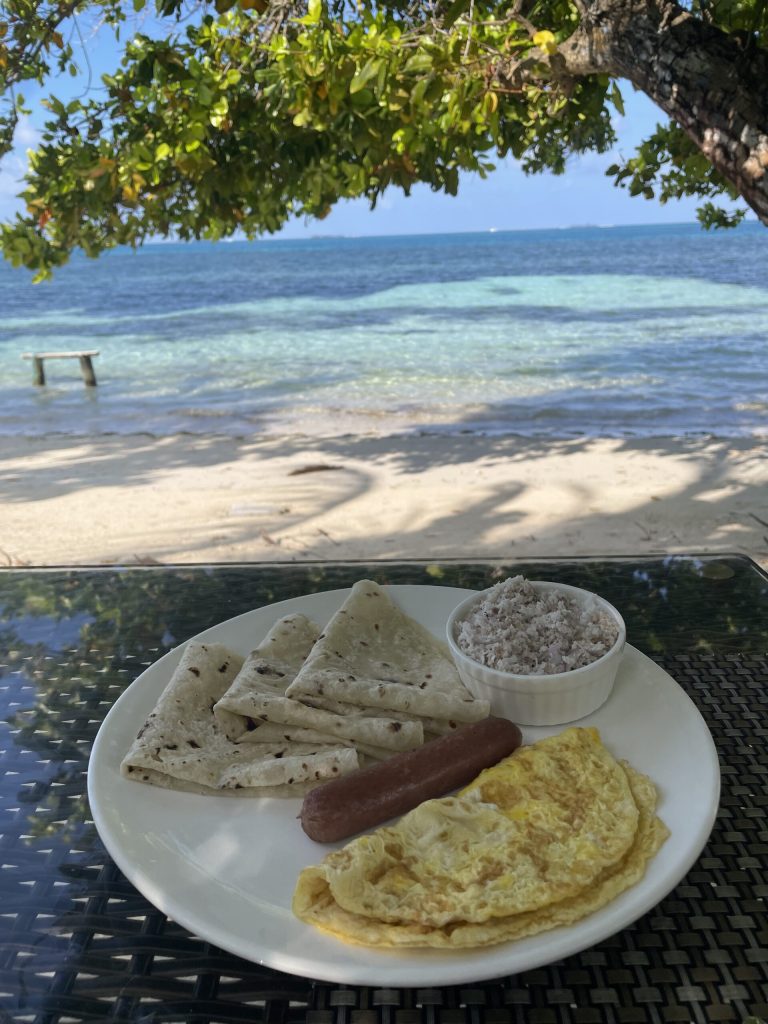Mas Huni and Roshi are the most classic dishes of a Maldivian breakfast.
The name comes from:
• “Mas” = fish
• “Huni” = coconut
It is a cold salad made of tuna (often smoked or canned, see below), grated coconut, onion, and chili, very similar to the pol sambol of Sri Lanka.
It is served with Roshi, a flatbread similar to chapati, and often with hot tea.
The Roshi is a disk, thin, soft and unleavened.
It is the daily accompaniment for breakfast, lunch, and dinner in the Maldivian islands.
Made only with flour, water, and salt (sometimes oil), cooked on a griddle without oil.
It pairs perfectly with traditional dishes such as Mas Huni, Riha (curry), Garudiya (clear fish broth).
In Maldivian cuisine, “disk” (sometimes also written as “dhīsk” or “dhisk”) is not a dish, but rather a term that indicates a type of thin bread or flatbread served with meals, similar to roshi.
Why is it a traditional breakfast?
• Local ingredients: all available on the island: tuna (caught), coconut (widespread), onion, flour.
• Nutritious yet light: perfect to start the day in a tropical climate.
• Easy to prepare in the morning, even without cooking (Mas Huni is served cold).
• National identity: every Maldivian knows it and many still eat it every morning.
This is what was eaten every morning on the island of Dhangethi, Maldives, at Endheri Sunset, during our stay in November 2025.

- Difficulty: Easy
- Cost: Medium
- Rest time: 15 Minutes
- Preparation time: 10 Minutes
- Portions: 4 People
- Cooking methods: Griddle
- Cuisine: Asian
- Seasonality: All seasons
Ingredients
- 5 oz tuna (dry smoked (Valho Mas))
- 3 1/2 cups coconut (grated)
- 1 green chili (finely chopped)
- 1 tablespoon lime juice
- 1 2/3 cups flour
- 1/2 cup water (warm)
- 1 tablespoon coconut oil
- to taste salt
Steps
In a bowl, mix the crumbled tuna with the grated coconut.
Add the chopped onion and chili.
Season with salt and (optionally) lime juice.
Mix well with hands or a spoon.
Serve at room temperature.
In a bowl, mix flour, salt, and oil.
Gradually add water, kneading until you get a soft but not sticky dough.
Cover and let rest for 15 minutes.
Divide into 4 balls and roll them into thin disks.Cook on a hot griddle (without oil) for about 1-2 minutes per side, until golden spots appear.
Serve hot along with Mas Huni.
Breakfast in the Maldives
Breakfast in the Maldives

FAQ
What are the roots of Roshi?
The Roshi did not originate “isolated” in the Maldives: it is the result of historical exchanges and cultural influences in the Indian Ocean.
1. Indian influence (especially South India)
• The Indian chapati or roti is the direct “ancestor” of the Roshi.
• The Maldives, being between India and Africa, absorbed elements of Dravidian and Tamil cuisine as early as the first millennium BC.
• The unleavened flatbread is practical for seafaring populations and easily paired with curries.
2. Arab
• Arab traders who introduced Islam in the 12th century also influenced culinary techniques.
• Flatbreads (like the khubz) were widespread among traders: the Roshi adapts well to that context, but with local ingredients (only simple flour, no oven needed).
3. Island context
On the islands, there are no traditional ovens nor a large availability of yeast: the Roshi is perfect because it is cooked on a griddle (tawa).
• Also, it is cheap, fast and versatile, ideal for Maldivian everyday life.What are the other main disks in Maldivian cuisine?
The Disks / Dhīsk are:
• Description: Small disks of bread or mashed rice, thinner and smaller than Roshi.
• Ingredients: Wheat flour or ground rice, water, salt.
• Cooking: On a griddle or lightly fried.
• Use: They serve as “single servings” for curries or Mas Baiy, allowing small portions of food to be taken without utensils.
Besides roshi, the most used are:
Bondibaiy / Bondibai
• Description: Small pancakes or scones made of flour and coconut.
• Ingredients: Wheat flour or rice, grated coconut, sometimes sugar or spices.
• Cooking: Fried or cooked on a griddle.
• Use: More often served at breakfast or as a snack with light curry or sambol.
Garudiya wrap
Description: Not exactly a disk, but often the Roshi or Disk is used to “wrap” small portions of Garudiya (tuna soup).
• Use: Eat the tuna soup with bread without a spoon.Which tuna is used for Mas Huni?
In the traditional Maldivian version of Mas Huni, tuna is the main ingredient and can vary slightly depending on availability and local habits. Here are the types traditionally used:
🐟 1. Dry smoked tuna (Valho Mas) – the most traditional
• Type: yellowfin tuna, locally caught, boiled, smoked, and then dried.
• Appearance: hard, dark brown, finely grated or shredded.
• Taste: savory, intense, smoky.
• Use: it is the most “authentic” and traditional type, used in Maldivian villages and homes.
—
🐟 2. Fresh cooked (boiled)
• If Valho Mas is not available, fresh boiled and shredded tuna is used.
• Less flavorful, but softer.
• Coconut, onion, chili, and salt are added, sometimes lime.
• It is used especially in resorts or families with access to fresh fish.
—
🐟 3. Canned (usually in brine)
• Practical and quick, often used today in cities and modern homes.
• Less traditional but very common.
• Preferred in brine, not in oil, to maintain the original taste.

